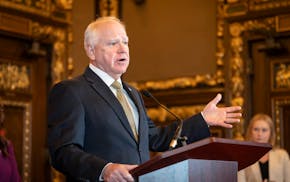Shoppers in the Twin Cities seven-county metro paid $677 million in additional sales taxes in 2024 after Minnesota lawmakers approved a 1% hike to fund housing and transportation projects.
The Legislature and Gov. Tim Walz enacted the tax increase in 2023, when Democrats had full control of state government, as a dedicated source of funding for some of their key priorities. Transportation needs receive 75% of the revenue and affordable housing 25%.
Lawmakers also created a 50-cent fee on deliveries orders of $100 or more that is expected to raise an additional $25 million this year. Revenue from that fee is also for transportation needs and is divvied up between cities, counties and the state.
Communities have not received a full year of revenue yet because the proceeds are only distributed twice a year. But money is coming in, and local leaders say it helps them expedite housing and transportation projects that otherwise would have to wait for funding.
How the housing money is used
The housing portion of the tax is divided between metro counties, cities and the state. It is used for emergency rental assistance, to build and preserve affordable housing and, after a modification to the statute in 2024, to operate homeless shelters.
The amount counties and cities receive is based on need, determined by the number of cost-burdened households, which is defined by their rent being more than 30% of their income.
Minnesota is short roughly 100,000 affordable homes for low-income residents, and about half that deficit is in Hennepin and Ramsey counties. Metro county leaders have focused much of the early revenues on helping housing providers repair existing units and stabilize their finances.
Once the existing affordable housing stock is stable, county leaders will turn their efforts to producing new units.
"It has had such a huge impact, the ability for us to have flexibility to meet the needs of our community," Ramsey County Commissioner Mai Chong Xiong said recently when the County Board approved how its local affordable housing aid would be spent.
Minnesota's housing crisis has shown no sign of slowing down. In January, eviction filings hit levels not seen since before the coronavirus pandemic and nine in 10 foreclosures are for unpaid rent.
Met Council takes on transit costs
The Metropolitan Council receives 83% of the revenue from the new transportation sales tax and the remaining 17% goes to counties based on population.
The Met Council will spend most of the money on transit, including operations, maintenance and new projects with 5% set aside for active transportation needs, like walking and biking.
The new revenue means counties no longer need to subsidize transit operations and can use the roughly $49 million in subsidies previously sent to the Met Council in other ways.
Lisa Cerney, Hennepin County's assistant county administrator for public works, said the county was able to add nine additional road reconstruction projects to its capital improvement plan because of the new tax revenue.
"This is definitely a tool that will allow us to get more reconstruction projects done," Cerney said. She noted that most of the funding would be focused on fixing roads and bridges.
Lawmakers strike a deal on state budget, Gov. Tim Walz calls Monday special session

Midea recalling 1.7 million of its popular air conditioners due to mold concern

Minnesota Muslims celebrate Eid al-Adha. What is the holiday?

Accomplished climber, photographer who recently moved from St. Paul missing on mountain
